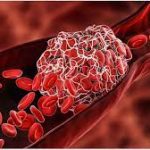Blood clot or thrombus is a serious condition that usually needs urgent treatment. These can happen in superficial or deep artery or vein of your body. These can also “travel” to other body parts (for example, the lungs) and cause life-threatening complications.
Cancer and surgery patients have an increased risk of getting blood clots.

Normal blood clotting involves specialized blood cells (platelets) and different proteins in the blood called clotting or coagulation factors. These platelets and coagulation factors clump together to heal broken blood vessels and control bleeding.
How bad is my blood clot?
Mild: A clot in small or superficial blood vessel (e.g. a blood clot that occurs in veins under the skin). You may have swelling and redness around the site of the clot. You may not need blood thinning medications but we recommend contacting your medical team if you suspect a blood clot.
Moderate: The blood clot involves a deep vein or any artery and you may have swelling, pain, redness or other local symptoms. Deeper blood clots can cause nausea, abdominal pain or other symptoms but you should generally not have any severe symptom listed below.
You need urgent medical attention including blood thinning medication. With timely input from your medical team, moderate blood clots can generally be managed at home. It involves deep vein thrombosis (a blood clot that occurs in a deep vein). You may experience pain and swelling.
Keep track of your symptom using Ankr (myAnkr web portal or the Ankr app). It will help you describe the uneasiness to your doctor or nurse.
Severe: A blood clots that happens in critical structures (e.g. lungs – pulmonary embolism, heart or brain). You are likely to have at least one of the warning signs/severe symptoms listed below.
This is a medical emergency. You should call 911 or seek immediate medical attention as appropriate.
Warning signs/severe symptoms of thrombus that need immediate medical attention
- Sudden coughing, which may bring up blood
- Leg pain or swelling
- Sharp chest pain or chest tightness
- Pain in your shoulder, arm, back, or jaw
- Rapid breathing or shortness of breath
- Pain when you breathe
- Multiple episodes of vomiting
- Blood in stool
- Severe light-headedness
- Fast heartbeat
- Stroke-like symptoms (weakness/numbness of any part of the body, blurry vision)
- Seizure
How to manage symptoms after a blood clot?
After you have connected your Doctor and received a plan to manage your blood clot, here aare some things you can do to feel better:
- Take your medications on time, and watch out for any bleeding
- Apply warm compression to the area
- Keep your affected leg or arm raised as much as possible
- Gradually increase physical activity as tolerated or advised by medical team
What caused my blood clot?
- Cancer that has spread to other parts of the body from where it started
- Cancer treatment (surgery, chemotherapy, radiation therapy, and hormone therapy).
- Anti-angiogenic drugs that block the formation of new blood vessels (thalidomide and lenalidomide)
- Treatment with erythropoiesis stimulating agents (epoetin and darbepoetin)
- Long-term use of an intravenous catheter or port
How to prevent a blood clot?
- Lower your risk by getting back to activity as soon as possible after surgery
- Exercise your legs during long trips
- Quit smoking
- Lose weight
- Manage other health problems such as diabetes, high blood pressure, and high cholesterol
How can Ankr help with your blood clot (thrombus)?
Don’t try to treat a clot by yourself. Use Ankr to:
(1) learn about the common symptoms of blood clot
(2) send message to your Doctor if they use Ankr platform*
(3) be better informed about how to prevent another blood clot
